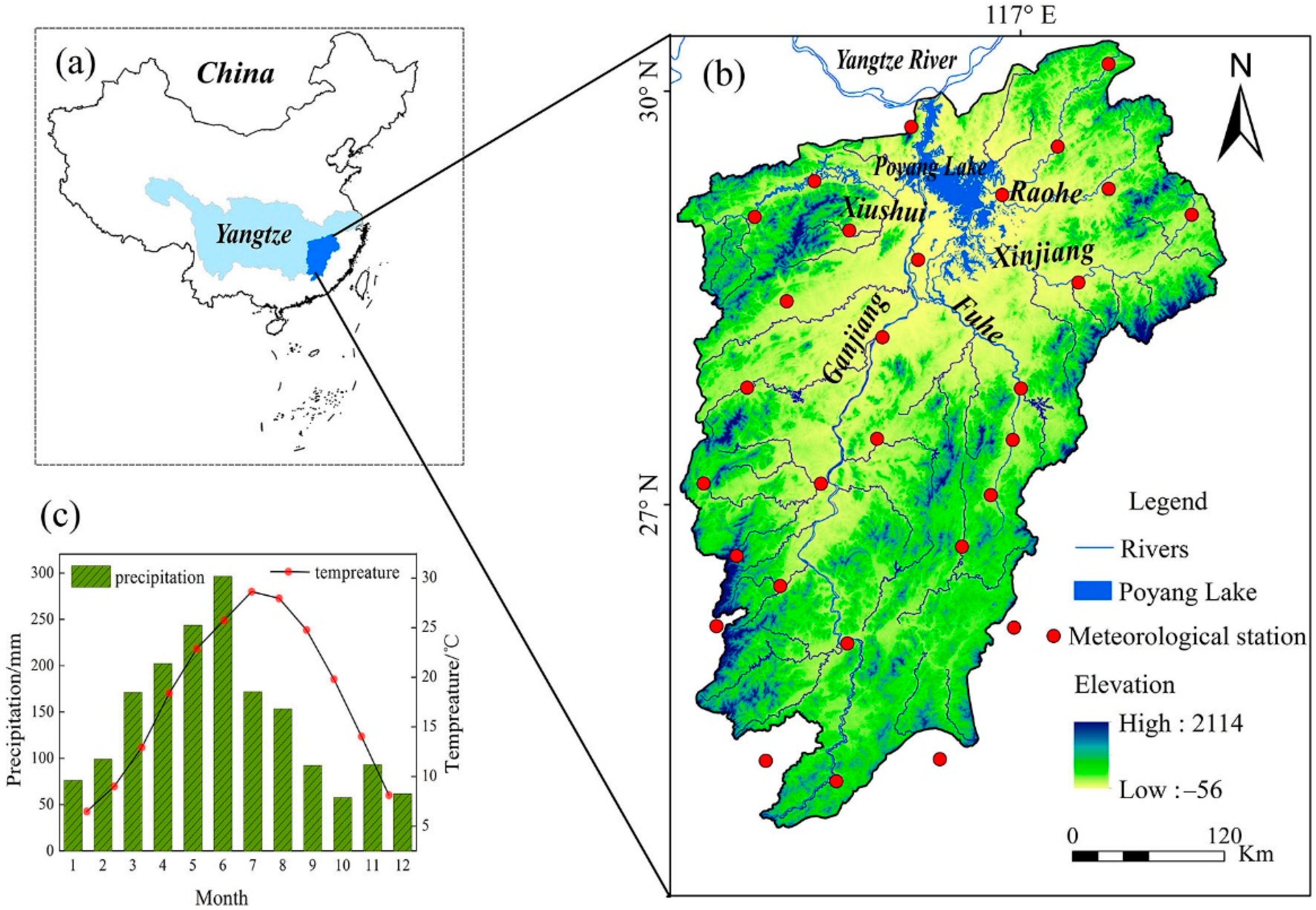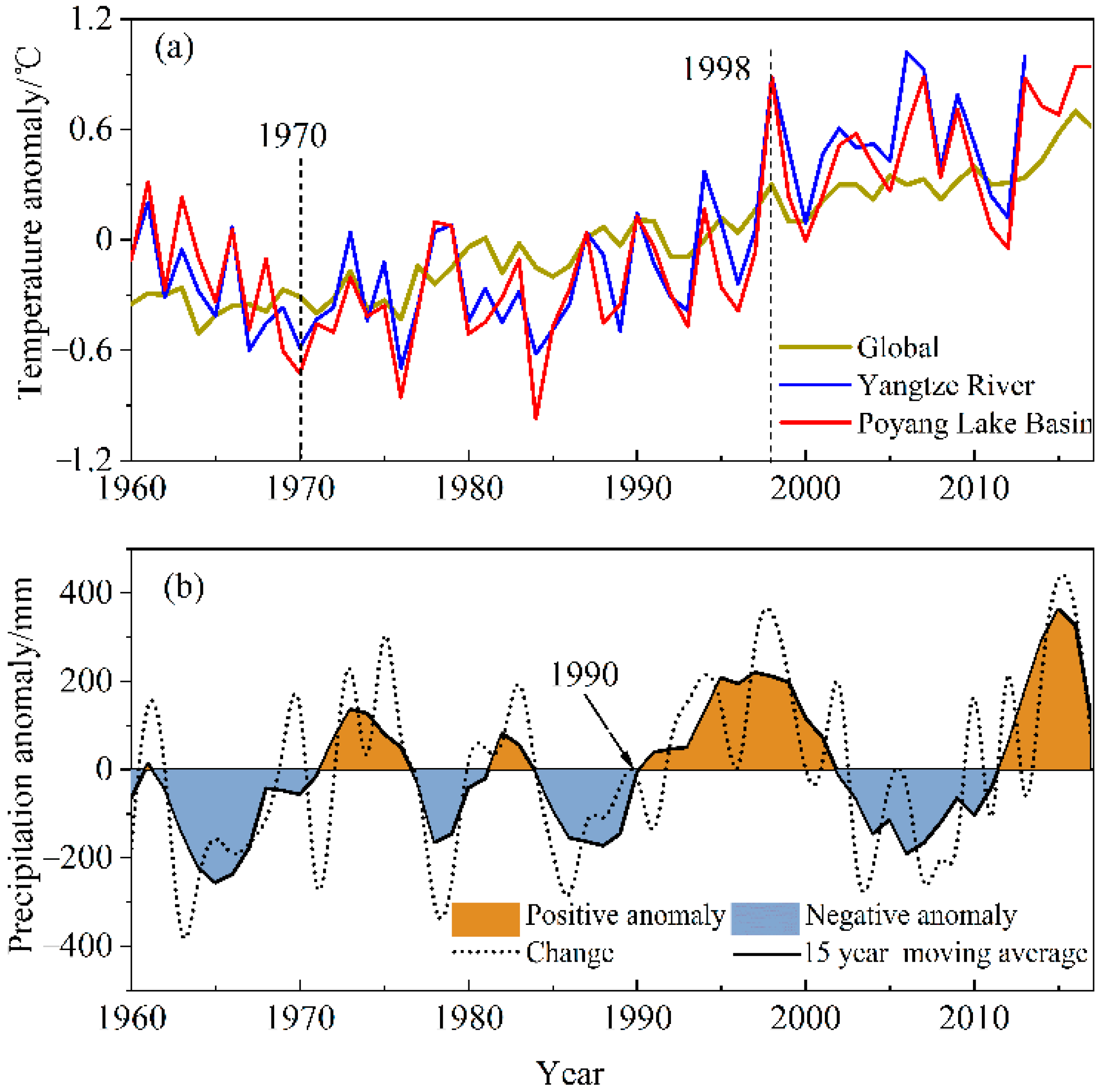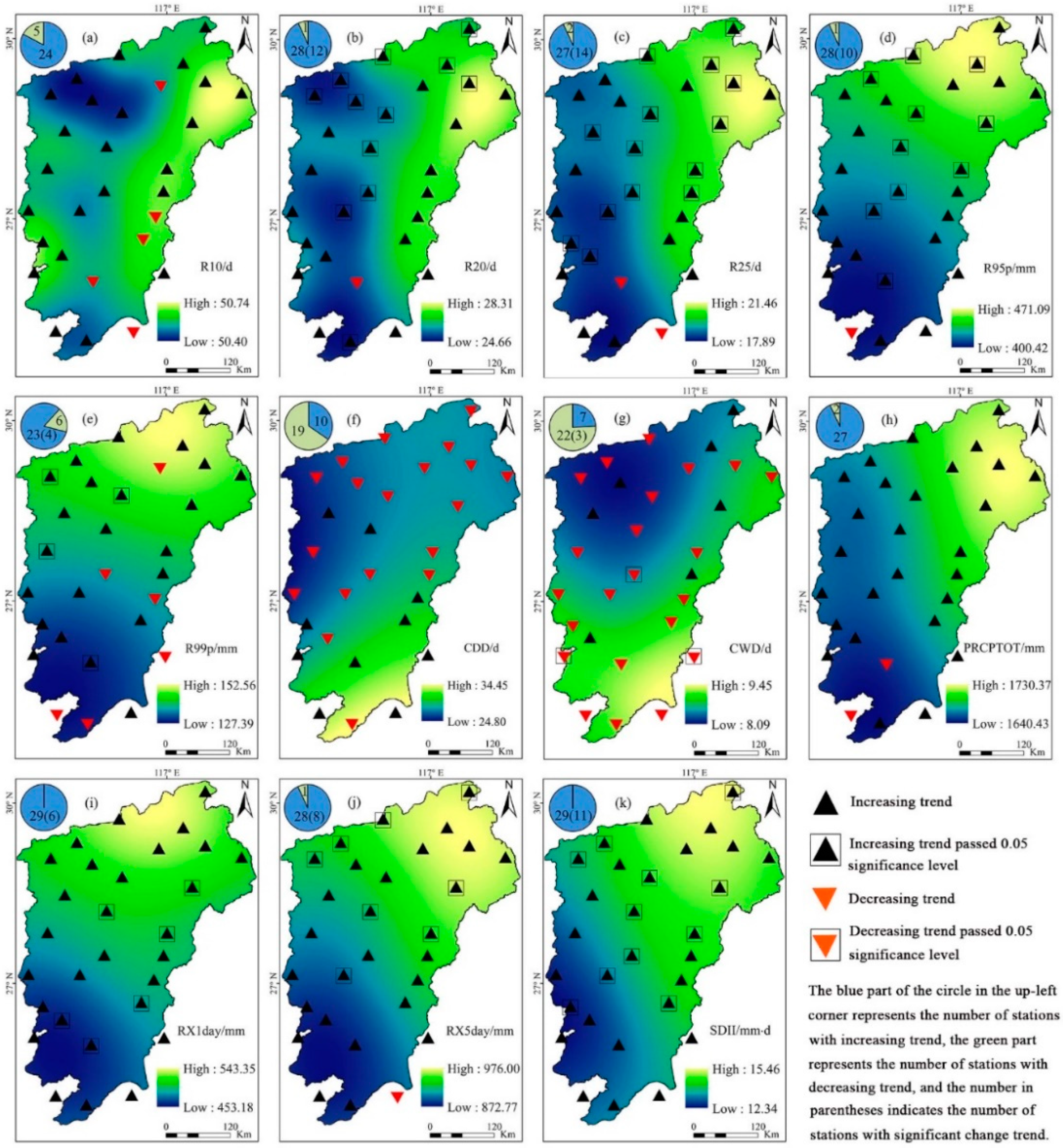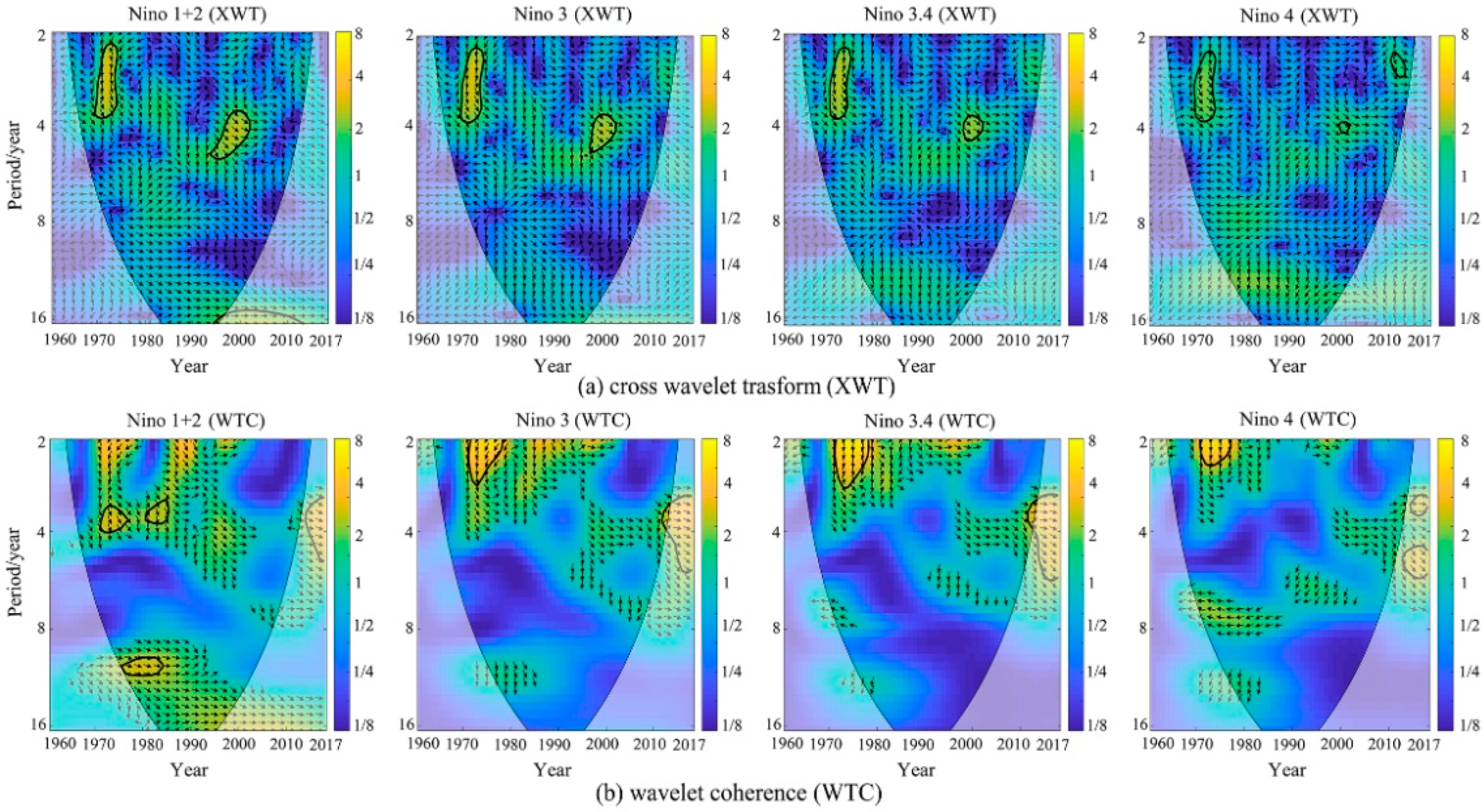Changes of Extreme Precipitation and Possible Influence of ENSO Events in a Humid Basin in China
Abstract
:1. Introduction
2. Materials and Methods
2.1. Study Area
2.2. Data Sources and Processing
2.3. Analysis of Temporal Variability
2.4. Correlation Analysis
2.5. Wavelet Analysis
3. Results
3.1. Climatic Background of Extreme Precipitation Change in the Poyang Lake Basin
3.2. Temporal Variation of Extreme Precipitation Indices
3.3. Spatial Variation of Extreme Precipitation Indices
- (1)
- Absolute indices: the spatial distribution patterns of R10, R20 and R25 are basically the same (Figure 3a–c), which generally decrease from east to west. In contrast, the spatial distribution of R10 and R20 is more dispersed and less continuous. The low value area of R10 is mainly concentrated in the northwest of the basin, and the decreasing trend is mainly located in the southeast. The spatial continuity of R25 is good, with an increasing trend in the center and west regions and a decreasing trend in the south regions.
- (2)
- Relative indices: the spatial distribution patterns of R95p and R99p are well consistent, which decreases from north to south (Figure 3d–e). The high value area is concentrated in the Poyang Lake area, Raohe and its surrounding areas in the east of the basin, and the low value area is concentrated in the Ganjiang basin in the south. In terms of temporal variation, R95p showed an increasing trend in the whole basin, and the increasing trend at four stations in the east and central of the basin is significant. However, a decreasing trend can be observed for R99p in the southeast mountainous area.
- (3)
- Continuity indices: spatially, CDD and CWD decrease from southeast to northwest, while PRCPTOT decreases from southwest to northeast (Figure 3f–h). The change trends of CDD and CWD at each stations vary greatly in the basin. Although a decreasing trend prevailed in the basin, some stations show an increasing trend. In contrast, an increasing trend of PRCPTOT was observed in most stations.
- (4)
- Intensity indices: The distributions of RX1day, RX5day and SDII have good spatial consistency (Figure 3i–k), which are characterized by the decreasing feature from northeast to southwest. During the study period, all three indices showed an increasing trend in the Poyang Lake Basin, especially SDII, which increased significantly at most stations along the direction of northwest–southeast.
3.4. Impact of ENSO on Extreme Precipitation
3.4.1. Linear Correlations between Extreme Precipitation Indices and ENSO Indices
3.4.2. Multi-Timescale Correlations between Extreme Precipitation Indices and ENSO Indices
3.4.3. Effects of Warm and Cold ENSO Events on Extreme Precipitation
4. Discussion
5. Conclusions
Author Contributions
Funding
Institutional Review Board Statement
Informed Consent Statement
Data Availability Statement
Acknowledgments
Conflicts of Interest
References
- Pachauri, R.; Reisinger, A. Climate change 2014: Synthesis report. Contribution of working groups I, II and III to the fifth assessment report of the intergovernmental panel on climate change. J. Rom. Stud. 2014, 4, 85–88. [Google Scholar]
- Yin, Z.E.; Tian, P.F.; Chi, X.X. Multi-scenario-based risk analysis of precipitation extremes in China during the past 60 years (1951–2011). Acta Geogr. Sin. 2018, 73, 405–413. [Google Scholar]
- Zhang, Z.X.; Fraedrich, K.; Jiang, T.; Zhang, J.C. Projection of future precipitation extremes in the Yangtze River Basin for 2001–2050. Adv. Clim. Chang. Res. 2007, 3, 340–344. [Google Scholar]
- Shi, G.X.; Liu, J.; Ma, L.; Li, C.H.; Chen, Q.; Zhang, H.M. Spatial–temporal variations of extreme precipitation events in Yangtze River Basin during 1970–2014. J. China Hydrol. 2017, 37, 77–85. [Google Scholar]
- Zhai, P.M.; Pan, X.H. Change in extreme temperature and precipitation over Northern China during the second half of the 20th century. Acta Geogr. Sin. 2003, 58, 1–10. [Google Scholar]
- Ren, G.Y.; Feng, G.L.; Yan, Z.W. Progresses in observation studies of climate extremes and changes in main–land China. Clim. Chang. Res. 2010, 15, 337–353. [Google Scholar]
- Li, S.S.; Kun, F.; Han, L.; Yan, J.P.; Wang, C.B.; Wu, Y.Q. Spatiotemporal variability of extreme precipitation and influencing factors on the Loess Plateau in northern Shaanxi province. Geogr. Res. 2020, 39, 140–151. [Google Scholar]
- Yuan, Z.; Yang, Z.; Yan, D.; Yin, J. Historical changes and future projection of extreme precipitation in China. Theor. Appl. Climatol. 2017, 127, 393–407. [Google Scholar] [CrossRef]
- Wang, X.; Jiang, D.; Lang, X. Extreme temperature and precipitation changes associated with four degree of global warming above pre-industrial levels. Int. J. Climatol. 2019, 39, 1822–1838. [Google Scholar] [CrossRef]
- Li, S.S.; Yang, S.N.; Liu, X.F. Spatiotemporal variability of extreme precipitation in north and south of the Qinling–Huaihe region and influencing factors during 1960–2013. Prog. Geogr. 2015, 34, 354–363. [Google Scholar]
- Zhang, Q.; Li, J.; Singh, V.P.; Xu, C.Y.; Deng, J. Influence of ENSO on precipitation in the East River basin, south China. J. Geophys. Res. Atmos. 2013, 118, 2207–2219. [Google Scholar] [CrossRef]
- Fu, C.B.; Teng, X.L. The relationship between China climate anomalies in summer and ENSO phenomena. J. Atmos. Sci. 1988, 12, 133–141. [Google Scholar]
- Zhang, R.; Sumi, A.; Kimoto, M. Impact of El Nio on the East Asian Monsoon: A Diagnostic Study of the ‘86/87 and ‘91/92 Events. J. Meteorol. Soc. Jpn. 1996, 74, 49–62. [Google Scholar] [CrossRef] [Green Version]
- Gong, D.; Wang, S. Impacts of ENSO on rainfall of global land and China. Chin. Sci. Bull. 1999, 44, 852–857. [Google Scholar] [CrossRef]
- Xiao, M.; Zhang, Q.; Singh, V.P. Spatiotemporal variations of extreme precipitation regimes during 1961–2010 and possible teleconnections with climate indices across China. Int. J. Climatol. 2017, 37, 468–479. [Google Scholar] [CrossRef]
- Guo, H.; Zhang, Q.; Wang, Y.J. Annual variations in climatic and hydrological processes and related flood and drought occurrences in the Poyang Lake basin. Acta Geogr. Sin. 2012, 67, 699–709. [Google Scholar]
- Min, S.; Liu, J. Characteristics and causes of the extreme precipitation anomaly in Lake Poyang area. J. Lake Sci. 2011, 23, 435–444. [Google Scholar]
- Liu, J.; Zhang, Q.; Gu, X.; Xiao, M.; Kong, D. Floods Characteristics and impacts from climate indices in the Poyang Lake basin. Sci. Geogr. Sin. 2016, 36, 1234–1242. [Google Scholar]
- Lei, X.; Gao, L.; Ma, M.; Dang, H.; Gao, J. Temporal–spatial and non–stationarity characteristics of extreme precipitation in the Poyang Lake basin, China. Chin. J. Appl. Ecol. 2021, 32, 3277–3287. [Google Scholar]
- Wang, Z.; Jia, Y.; Hong, Y.; Li, H.; Jiang, M. Spatiotemporal variation of drought and flood series in the Poyang Lake basin in recent 550 years based on EEMD and EOF analysis. Resour. Environ. Yangtze Basin 2018, 27, 919–928. [Google Scholar]
- Wei, F.Y. Modern Climate Statistical Diagnosis and Prediction Technology; China Meteorological Press: Beijing, China, 2007. [Google Scholar]
- Sen, P.K. Estimates of the Regression Coefficient Based on Kendall’s Tau. J. Am. Stat. Assoc. 1968, 63, 1379–1389. [Google Scholar] [CrossRef]
- Kahya, E.; Partal, T. Is seasonal precipitation decreasing or increasing in Turkey? Online J. Earth Sci. 2007, 1, 43–46. [Google Scholar]
- Grinsted, A.; Moore, J.C.; Jevrejeva, S. Application of the cross wavelet transform and wavelet coherence to geophysical time series. Nonlinear Proc. Geophys. 2004, 11, 561–566. [Google Scholar] [CrossRef]
- Zhang, Q.; Xu, C.Y.; Jiang, T.; Wu, Y. Possible influence of ENSO on annual maximum streamflow of the Yangtze River, China. J. Hydrol. 2007, 333, 265–274. [Google Scholar] [CrossRef]
- Zheng, J.Y.; Zhang, Q.; Shi, P.J.; Gu, X.H.; Zheng, Y.J. Spatiotemporal characteristics of extreme precipitation regimes and related driving factors in the Pearl River Basin. Sci. Geogr. Sin. 2017, 37, 283–291. [Google Scholar]
- Wu, S.A.; Jiang, Z.H.; Liu, Z.X. Study on the correlations between decadal variability of pacific ssta and that of rainfall in China. J. Trop. Meteorol. 2005, 21, 153–162. [Google Scholar]
- Wei, W.; Zhang, R.; Wen, M.; Rong, X.; Li, T. Impact of Indian summer monsoon on the South Asian High and its influence on summer rainfall over China. Clim. Dyn. 2014, 43, 1257–1269. [Google Scholar] [CrossRef]
- Xiao, M.; Zhang, Q.; Singh, V.P. Influences of ENSO, NAO, IOD and PDO on seasonal precipitation regimes in the Yangtze River basin, China. Int. J. Climatol. 2015, 35, 3556–3567. [Google Scholar] [CrossRef]
- Iii, J.K.; Miyakoda, K.; Yang, S. Recent change in the connection from the Asian monsoon to ENSO. J. Clim. 2002, 15, 1203–1215. [Google Scholar]
- Yin, Y.; Xu, Y.; Chen, Y. Relationship between flood/drought disasters and ENSO from 1857 to 2003 in the Taihu Lake basin, China. Quat. Int. 2009, 208, 93–101. [Google Scholar] [CrossRef]
- Wang, B.; Yang, J.; Zhou, T. Interdecadal changes in the major modes of Asian–Australian monsoon variability: Strengthening relationship with ENSO since the late 1970s. J. Clim. 2008, 21, 1771–1789. [Google Scholar] [CrossRef]
- Latif, M.; Semenov, V.A.; Park, W. Super El Niños in response to global warming in a climate model. Clim. Chang. 2015, 132, 489–500. [Google Scholar] [CrossRef] [Green Version]
- Chen, Y.; Zhou, R.; Wu, H. Features of the western pacific subtropical high duringthe warm and cool periods of Nino 1 + 2 area and its influence on the East Asian Monsoon. Chin. J. Atmos. Sci. 2002, 26, 373–386. [Google Scholar] [CrossRef]
- Zhang, W.; Qian, Y. The relationships between variations of sea surface temperature anomalies in the key ocean areas and the precipitation and surface air temperature in China. Adv. Atmos. Sci. 2001, 18, 294–308. [Google Scholar]
- Lǜ, J.; Ju, J.; Jiang, J. Interdecadal regime shifts of regional precipitation over eastern China during the last 100 years. Chin. J. Atmos. Sci. 2009, 33, 524–536. [Google Scholar]
- Ma, D.; Liu, Y.; Chen, J.; Zheng, L.; Zhang, W. Farmers’ vulnerability to flooding in the Poyang lake region. Acta Geogr. Sin. 2007, 32, 321–333. [Google Scholar]
- Qu, S.; Wang, L.; Lin, A.; Zhu, H.; Yuan, M. What drives the vegetation restoration in Yangtze River basin, China: Climate change or anthropogenic factors? Ecol. Indic. 2018, 90, 438–450. [Google Scholar] [CrossRef]
- Jiang, S.S.; Zhang, Z.X.; Wang, W.L.; Du, W.; Jin, Q. Dynamic variation rules of vegetation cover in Jiangsu Province and its response to climate change. J. Nanjing For. Univ. 2016, 40, 74–80. [Google Scholar]





| Category | Code | Name | Definition | Unit |
|---|---|---|---|---|
| Absolute index | R10 | Number of heavy precipitation days | Annual count of days when precipitation > = 10 mm | d |
| R20 | Number of very heavy precipitation days | Annual count of days when precipitation > = 20 mm | d | |
| R25 | Number of extreme heavy precipitation days | Annual count of days when precipitation > = 25 mm | d | |
| Relative index | R95p | Very wet days | Annual total precipitation when daily precipitation > 95th percentile | mm |
| R99p | Extremely wet days | Annual total precipitation when daily precipitation > 99th percentile | mm | |
| Continuity index | CDD | Consecutive dry days | Maximum number of consecutive days with daily precipitation < 1 mm | d |
| CWD | Consecutive wet days | Maximum number of consecutive days with daily precipitation > = 1 mm | d | |
| PRCPTOT | Annual total wet–day precipitation | Annual total daily precipitation in wet days | mm | |
| Intensity index | RX1day | Max 1-day precipitation amount | Monthly maximum 1-day precipitation | mm |
| RX5day | Max 5-day precipitation amount | Monthly maximum consecutive 5-day precipitation | mm | |
| SDII | Simple daily intensity index | Annual total daily precipitation in wet days | mm/d |
| Extreme Precipitation Index | Slope | Change Point | Site Ratio/% | ||
|---|---|---|---|---|---|
| Increasing | Decreasing | ||||
| Absolute index | R10 | 0.54 d/10a | 2011 | 86.21% | 13.79% |
| R20 | 0.75 d/10a | 1991 * | 96.55% | 3.45% | |
| R25 | 0.78 d/10a * | 1991 * | 96.55% | 3.45% | |
| Relative index | R95p | 26.74 mm/10a * | 1991 * | 96.55% | 3.45% |
| R99p | 11.90 mm/10a * | 1992 * | 86.21% | 13.79% | |
| Continuity index | CDD | –0.06 d /10a | 2014 * | 34.48% | 65.52% |
| CWD | –0.10 d/10a | 1999 * | 24.14% | 75.86% | |
| PRCPTOT | 0.58 mm/10a | 1991 | 93.10% | 6.09% | |
| Intensity index | RX1day | 14.14 mm/10a * | 1992 * | 100% | — |
| RX5day | 29.13 mm/10a * | 1991 * | 96.55% | 3.45% | |
| SDII | 0.32 (mm/d)·10a ** | 1991 * | 100% | — | |
| Extreme Precipitation Index | ENSO Index | ||||
|---|---|---|---|---|---|
| Nino 1 + 2 | Nino 3 | Nino 4 | Nino 3.4 | ||
| Absolute index | R10 | 0.37 ** | 0.31 * | 0.14 | 0.25 |
| R20 | 0.33 * | 0.26 | 0.14 | 0.20 | |
| R25 | 0.31 * | 0.24 | 0.14 | 0.19 | |
| Relative index | R95p | 0.25 | 0.16 | 0.10 | 0.09 |
| R99p | 0.17 | 0.13 | 0.15 | 0.10 | |
| Continuity index | CDD | –0.02 | –0.04 | –0.07 | –0.07 |
| CWD | 0.09 | 0.04 | 0.03 | 0.03 | |
| PRCPTOT | 0.33 * | 0.26 | 0.13 | 0.19 | |
| Intensity index | RX1day | 0.32 * | 0.27 * | 0.21 | 0.20 |
| RX5day | 0.28 * | 0.22 | 0.15 | 0.16 | |
| SDII | 0.28 * | 0.22 | 0.17 | 0.15 | |
Publisher’s Note: MDPI stays neutral with regard to jurisdictional claims in published maps and institutional affiliations. |
© 2021 by the authors. Licensee MDPI, Basel, Switzerland. This article is an open access article distributed under the terms and conditions of the Creative Commons Attribution (CC BY) license (https://creativecommons.org/licenses/by/4.0/).
Share and Cite
Yang, X.; Wu, J.; Liu, J.; Ye, X. Changes of Extreme Precipitation and Possible Influence of ENSO Events in a Humid Basin in China. Atmosphere 2021, 12, 1522. https://doi.org/10.3390/atmos12111522
Yang X, Wu J, Liu J, Ye X. Changes of Extreme Precipitation and Possible Influence of ENSO Events in a Humid Basin in China. Atmosphere. 2021; 12(11):1522. https://doi.org/10.3390/atmos12111522
Chicago/Turabian StyleYang, Xiaoxia, Juan Wu, Jia Liu, and Xuchun Ye. 2021. "Changes of Extreme Precipitation and Possible Influence of ENSO Events in a Humid Basin in China" Atmosphere 12, no. 11: 1522. https://doi.org/10.3390/atmos12111522
APA StyleYang, X., Wu, J., Liu, J., & Ye, X. (2021). Changes of Extreme Precipitation and Possible Influence of ENSO Events in a Humid Basin in China. Atmosphere, 12(11), 1522. https://doi.org/10.3390/atmos12111522







